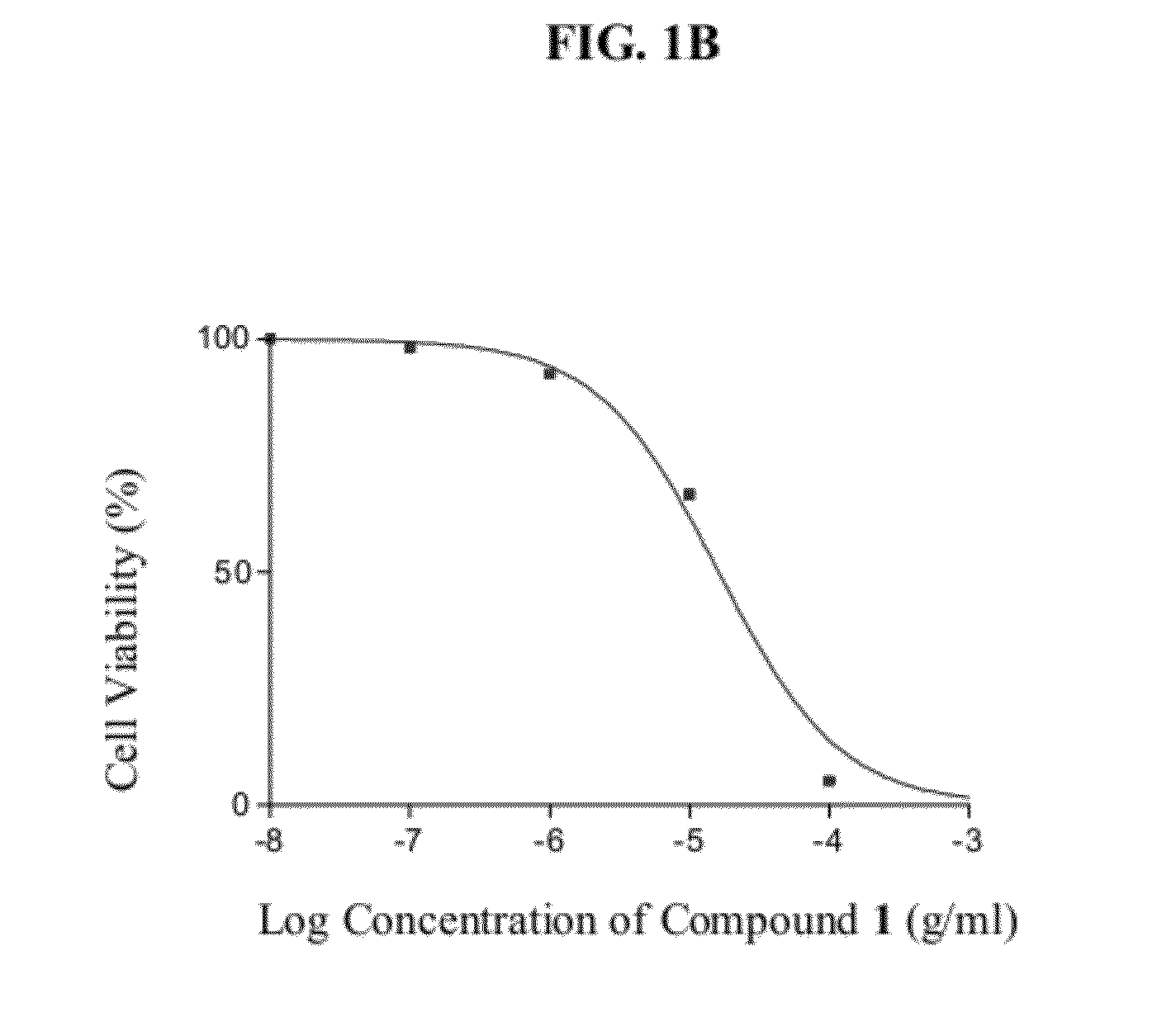Methods and compositions for treating lung cancer
- Summary
- Abstract
- Description
- Claims
- Application Information
AI Technical Summary
Benefits of technology
Problems solved by technology
Method used
Image
Examples
example 1
Preparation of the Exemplary Cyclohexenone Compounds
[0166]One hundred grams of mycelia, fruiting bodies or mixture of both from Antrodia camphorata were placed into a flask. A proper amount of water and alcohol (70-100% alcohol solution) was added into the flask and were stirred at 20-25° C. for at least 1 hour. The solution was filtered through a filter and 0.45 μm membrane and the filtrate was collected as the extract.
[0167]The filtrate of Antrodia camphorate was subjected to High Performance Liquid chromatography (HPLC) analysis. The separation was performed on a RP18 column, the mobile phase consisted of methanol (A) and 0.3% acetic acid (B), with the gradient conditions of 0-10 min in 95%-20% B, 10-20 min in 20%-10% B, 20-35 min in l0%-10% B, 35-40 min in 10%-95% B, at the flow rate of 1 ml / min. The column effluent was monitored with a UV-visible detector.
[0168]The fractions collected at 21.2 to 21.4 min were collected and concentrated to yield compound 5, a product of pale yel...
example 2
In Vitro Survival Assay for Anti-Lung Cancer Effects
[0174]The NCI anti-cancer drug screen model was adopted to test anti-cancer effect of the exemplary compounds from Example 1. The isolated compound 1 from Example 1 was added into the culture media of human lung-cancer cells, A549, NCI-H460, CL1-0, CL1-5 or DMS 114, to test for tumor cell survival (either by MTT assay or colony formation assay). Compounds 4, 5, 6, and 7 were used in MTT assay against A549.
[0175]A549, CL1-0, and CL1-5 cells are human lung adenocarcinoma cell lines. CL1-0 cells are minimally invasive sub-lines with low migration. CL1-5 cell line, on the other hand, is highly invasive with high migration ability. The NCI-H460 cell line is derived from human large cell lung cancer, which is one of the major types of non-small cell lung carcinoma. DMS 114 is small cell lung cancer cell line, and was obtained from the American Type Culture Collection (Manassas, Va.).
MTT Assay
[0176]MTT assay is commonly used to determine ...
example 3
In Vitro Lung Cancer Cells Apoptosis Analysis
[0186]At different incubation time points (24, 48, and 72 hours), the compound 1 treated (0, 0.1, 0.3, 0.6, or 1 μg / ml) human lung cancer cell lines A549 and CL1-5 were collected. The cells were washed and fixated in 100% ethanol at 4° C. for one hour. After removal of ethanol, the cells were incubated with 2 mg / ml of RNase A at 37° C. for at least 30 minutes. The cells-were dyed with 50 μg / ml of propidium iodide at 4° C. and analyzed by flow cytometry (Beckman Coulter Photeome Lab™ PF 2D). The DNA contents of cells are shown in FIGS. 5 and 6.
[0187]Referring to FIG. 5, the results show that A549 human lung cancer cell survival rate decreased after 48 hours treatment of the exemplary compound 1. The higher concentrated of compound 1, the more significant decrease of cell survival rate. This indicates the increase of cell apoptosis of human lung cancer cell A549. In FIG. 6, the results show that human lung cancer cell CL1-5 survival rate si...
PUM
| Property | Measurement | Unit |
|---|---|---|
| Cell death | aaaaa | aaaaa |
| Size | aaaaa | aaaaa |
| Volume | aaaaa | aaaaa |
Abstract
Description
Claims
Application Information
 Login to View More
Login to View More - R&D
- Intellectual Property
- Life Sciences
- Materials
- Tech Scout
- Unparalleled Data Quality
- Higher Quality Content
- 60% Fewer Hallucinations
Browse by: Latest US Patents, China's latest patents, Technical Efficacy Thesaurus, Application Domain, Technology Topic, Popular Technical Reports.
© 2025 PatSnap. All rights reserved.Legal|Privacy policy|Modern Slavery Act Transparency Statement|Sitemap|About US| Contact US: help@patsnap.com



